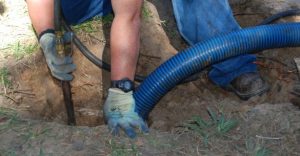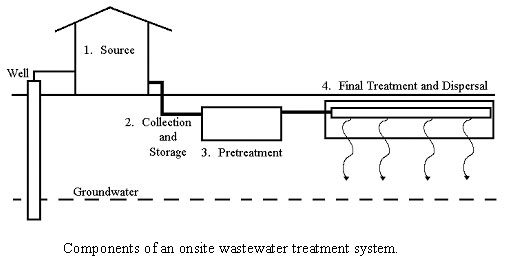Responding to Electrical Power Outages and Floods
INTRODUCTION

Electrical power outages and floods can impact you and your residential onsite wastewater treatment system. These onsite wastewater treatment systems remove organic matter, solids and living organisms (viruses, bacteria, and protozoa) from wastewater thus protecting public health and the environment. The appropriate response to a disaster depends upon the treatment technology you are using for treatment of your wastewater and the type of disaster. This document will discuss the components of an onsite wastewater treatment system and the potential hazards associated with electrical power outages and flooding.
ON-SITE WASTEWATER TREATMENT SYSTEM COMPONENTS
To properly respond to a disaster, homeowners need to know the components of their onsite wastewater treatment system. These systems can be divided into four components: wastewater source or use, wastewater collection, pretreatment, and final treatment and dispersal.

The wastewater source or use is actually the type of facility that the wastewater treatment system is serving; it can be a residence or a commercial operation.
The wastewater collection system is generally the plumbing that conveys the wastewater to the pretreatment component. Most collection components are constructed of piping placed on a slope to allow gravity to move the wastewater through the collection component to the pretreatment component. However, some collection components have a pump tank and pump placed in the plumbing network to collect wastewater from the facility and then pump the wastewater to the pretreatment components.
The pretreatment component varies with site conditions and the type of final treatment and dispersal component installed. The pretreatment component removes contaminants from the wastewater to obtain an effluent that can be accepted and treated by the final treatment and dispersal component. Pretreatment components include septic tanks, aerobic treatment units, media filters, constructed wetlands and/or disinfection units.
The final treatment and dispersal component completes the wastewater treatment process and discharges the effluent into the receiving environment. Final treatment and dispersal components include media-filled trenches, gravel-less trench technology, low-pressure pipe drain fields, drip distribution fields, or spray distribution fields.
Additional information on these technologies is available on the Onsite Wastewater Treatment & Reuse web site at http://ossf.tamu.edu.
ELECTRICAL OUTAGES
Electrical outages are the most common type of interruption of service due to a variety of circumstances. The appropriate response depends on the type of pretreatment and final treatment and dispersal components of your onsite wastewater treatment system. A gravity collection system feeding into a septic tank and gravity distribution soil absorption area will continue to operate properly and you will be able to continue using your system. However, if your system contains components require electricity to operation, the wastewater will collect in the system during the electrical outage and have to be treated and dispersed when electrical service resumes. Such components include:
- Aerobic treatment units
- Sand filters
- Re-circulating media filters
- Flow equalization tanks
- Low pressure distribution
- Subsurface drip distribution
- Spray distribution
These components usually have a reserve or alarm capacity that allows some use during electrical power outages or when components break. However, the minimum required reserve capacity for compliance with regulations in Texas is one-third of the daily design flow. Thus, a three bedroom residence would have a reserve capacity of 80 gallons.
If you have an electrical power outage and have electrically-operated components:
Limit water usage to essentials such as toilet flushing and hand washing. Laundry, bathing, showers, and dishwashing should be minimized or eliminated.
Stop all water use if electrical outage is extended or the plumbing begins to drain slowly. Slow-draining plumbing may indicate that the reserve capacity is exceeded and the system is full.
Once power is restored:
Limit laundry and dishwashing if your system has an advanced pretreatment component and if the power outage is less than one day. Otherwise, discontinue these activities if the power outage is longer than one day. Limit showers and baths or at least one day if the power outage is greater than one day. This period of time allows the microbial population treating the wastewater to regain productivity and properly treat the wastewater.
Allow the system to continue to operate normally until the water level recedes in the system. A time dosed system may take a 24 hour period to have all of the stored water distributed and the high water alarm deactivated. System components that require electricity are usually equipped with a high water alarm. This alarm may sound when the power is restored based on your water usage during the power outage. You can silence the alarm if it has a silence switch option. If the alarm remains activated more than 24 hours, contact your service provider.
Where applicable, manually control the dose duration of the treated wastewater delivered to the dispersal field to prevent flooding of the field. If the final treatment and dispersal component has an on-demand pumping system, the first dose following restoration of power can overload your system.
FLOODING
In a flood situation the onsite wastewater treatment system is inundated with surface water. The impact of the flooding on the onsite wastewater treatment system will be related to the elevation of the flooding over the system and the length of time the system is flooded. During a flood:
Discontinue electrical power to the system by turning off power at the main circuit panel.
Stop water usage going into the system because of the potential for limited treatment.
Plug any floor drains in the home connected to the wastewater treatment system to prevent water from backing up through the system and into the home.
After a flood:
Do not use the system until the flood water has receded from all components of the system.
Inspect the system for any signs of damage to the surface of the system (i.e. exposed components because soil has washed away and damage to lids or inspection ports).
Call a service provider to check the system for sediment or other debris if the system components are filled with flood water. Some water may be removed from the pretreatment components to reduce the water level to the normal operating level. Do not pump the tanks empty or below their normal operating lever because the ground will usually be saturated after flooding and empty tanks are buoyant and will try to float out of the ground. This upward force can make the tanks shift resulting in damaged piping or even cause them to float to the ground surface.
If your final treatment and dispersal component is a trench system and it has inspection ports, the service provider may be able to pump water from the trenches to help the soil dry and aerate.
If the onsite wastewater treatment system has components requiring electrical power, the ability to restart the system depends on the flood elevation. If the flood water only covered the tanks and the components in the tanks, the system may be able to be restarted without further evaluation of the components. If the flood water covered components located on the ground surface (i.e. air pumps, panels), the systems should be inspected by a service provider to determine the condition of the components before using the system and restarting electrical service.
SUMMARY
Electrical power outages and floods do occur and can impact your system. During these events, wastewater treatment can be limited and can pose health concerns and hazards if not managed appropriately. The homeowner needs to be aware of their onsite wastewater treatment system components and the appropriate response based on their components.
